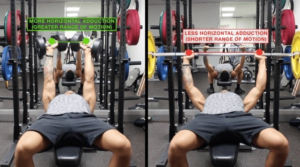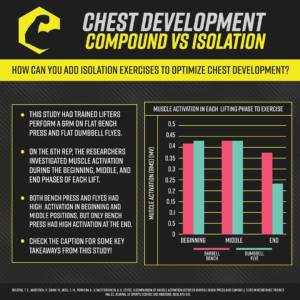BB BENCH PRESS vs. OTHER PUSH EXERCISES
Click on Image to Enlarge
EMG STUDIES
PECTORALIS MAJOR
– BB Bench Press Flat vs. DB Bench Press Flat vs. Machine Chest Press vs. Tricep Extension
Maximal Strength Performance and Muscle Activation for the Bench Press and Triceps Extension Exercises Adopting Dumbbell, Barbell, and Machine Modalities Over Multiple Sets – Farias – 2017
Procedure
– 3 bench press (BP) exercise modes (Smith machine [SMBP], barbell [BBP], and dumbbell [DBP]) that were followed by a triceps extension (TE)
– 19 trained men performed 3 testing protocols in random order, which included: (P1) SMBP + TE; (P2) BBP + TE; and (P3) DBP + TE
– 4 sets with a 10-repetition maximum (RM) load, immediately followed by a TE exercise for 4 sets with a 10RM load.
– 2-minute rest interval between sets and exercises.
PECTORALIS MAJOR
– BB Bench Press Flat vs. DB Bench Press Flat vs. DB Fly
EMG – Pectoralis Major and Anterior Deltoid during 3 Upper Body Lifts – 2005 – Welsch
Procedure
– 12 college-age men and women with various degrees of lifting experience; performed 3 repetitions using the 6RM
Results
– dumbbell fly had significantly less relative time of activation than did barbell or dumbbell bench presses
Pectoralis Major – average activation: bb bench 90% · db bench 80% · db fly 65%
+ Anterior Deltoid – average activation: bb bench 90% · db bench 85% · db fly 70%
PECTORALIS MAJOR UPPER, MIDDLE & LOWER
– BB Bench Press Flat vs. DB Fly
A Comparison of Muscle Activation between BB Bench and DB Flyes in Resistance-Trained Males – 2020 – Solstad, Saeterbakken
Procedure
– 17 resistance-trained men with 4.8 ± 2.0 years resistance training experience
– 6RM; the 5th repetition was tested, dividing it into six phases (lower, middle, and upper phase of the descending and ascending movement
Results
Pectoralis Major – upper: bench 35% · db fly 25%
Pectoralis Major – middle: bench 40% · db fly 40%
Pectoralis Major – lower: bench 40% · db fly 40%
+ Biceps Brachii: db fly 60% · bench 15%
Predicted 1RM
– BB Bench Press, Bilateral DB Press, Unilateral DB Press
Relationship of Barbell and Dumbbell Repetitions With One Repetition Maximum Bench Press in College Football Players – Heinecke – 2021
Procedure
– D2 football players (n = 40) with a minimum of 1 year of collegiate resistance training experience
-Backs (running backs, wide receiver, linebackers, and quarterbacks) and linemen (offensive and defensive interior linemen and tight ends)
– BB repetitions were performed with a 90.9kg (200lbs) load. This load was selected because anecdotal observation of players during training suggested they had difficulty balancing bilateral dumbbells when using amounts greater than 45.5kg (100lbs) in each hand
– Shoulder width or slightly wider grip
Results
– Backs produced significantly fewer DB reps than BP reps, while linemen produced approximately the same number
– However, when the effect of body mass was removed by covariance, there was no significant difference b/n linemen and backs on any performance variables
Outcome
(1) Research has suggested alterations in neural and/or neuromuscular function typically accompany strength training. This might support unilateral and bilateral training to facilitate performance in a limb-dependent task such as a bilateral bench press because the arms need to function in a coordinated fashion
(2) The slight difference between unilateral DB presses could suggest that lifting a BB may be limited by the ability of the nondominant arm to maintain a smooth pattern throughout the movement through neuromotor control
(3) Validation of the predictive accuracy of bilateral and unilateral DB RTF to estimate 1RM BB bench press. There was a slight but significant difference between bilateral DB RTF and BB RTF, but this difference did not affect the ability of either method to predict maximal supine barbell pressing strength



